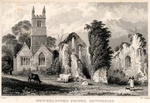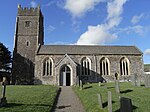Frithelstock

Frithelstock (pronounced Frizzlestock) is a village, civil parish and former manor in Devon, England. It is located within Torridge local authority area and formed part of the historic Shebbear hundred. The parish is surrounded, clockwise from the north, by the parishes of Monkleigh, Great Torrington, Little Torrington, Langtree and Buckland Brewer. In 2001 its population was 366, down from 429 in 1901.The name derives from the Anglo-Saxon Frithulac's Stocc. The ruins of Frithelstock Priory are adjacent to the north east side of the parish church of St Mary and St Gregory, and represent the only substantial remains of a monastic house in Devon.As of 2013 the village had one public house, the Clinton Arms, which since closed in 2018. The parish church of St. Mary & St. Gregory was enlarged in the 15th century and underwent a Victorian restoration in about 1870.
Excerpt from the Wikipedia article Frithelstock (License: CC BY-SA 3.0, Authors, Images).Frithelstock
A388, Torridge District Frithelstock
Geographical coordinates (GPS) Address Nearby Places Show on map
Geographical coordinates (GPS)
| Latitude | Longitude |
|---|---|
| N 50.9465 ° | E -4.204 ° |
Address
A388
EX38 8JR Torridge District, Frithelstock
England, United Kingdom
Open on Google Maps










